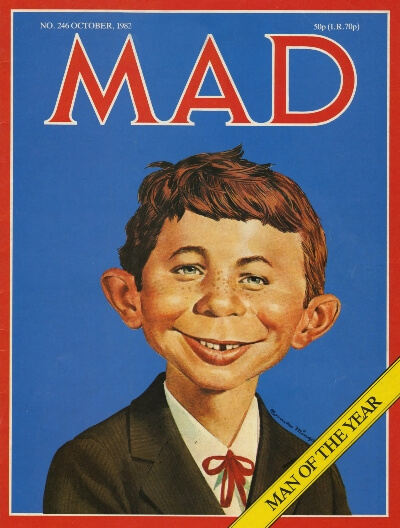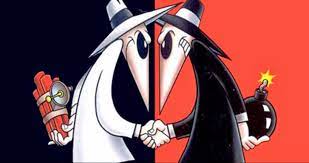At 67, I am now almost the same age as MAD magazine, which is celebrating 70 years this month. I have been collecting them for nearly as long. Battered cardboard boxes filled with decades of well-read, dog-eared MAD magazines, have followed me in the trajectory of my life. From my childhood suburban bedroom in West Hempstead, Long Island, to my Upper West side apartment in Manhattan, they are now resting comfortably back on Long Island in the cool basement of my Huntington Village home.
Because of MAD I would be inoculated with a heavy dose of skepticism offering a lifetime of immunity from accepting institutional hypocrisy and dishonesty.
Growing up in the 1960s atomic age of nuclear families and nuclear jitters, cold warriors and hot wars, mad men and happy housewives, MAD’s cynical eye offered a road map to navigate this rapidly changing world. Because of MAD I would be inoculated with a heavy dose of skepticism offering a lifetime of immunity from accepting institutional hypocrisy and dishonesty.
Published during the deep freeze of the Cold War, MADs parodies helped take a bit of the chill out of the air. The never-ending battle between black and white but otherwise identical spies in artist Antonio Prohias’s classic feature Spy vs Spy was a perfect representation of cold war antagonists bent on annihilating each other by any means necessary but doomed to an eternal standoff. In the frightening duck n’ cover climate of a childhood colored by the policy of Mutually Assured Destruction, it was a poignant social commentary on the absurdity and MADness of the cold war.
It is not surprising my own creative journey began with MAD. Just as I would read, re-read, and scrutinize each and every article with the devotion of a Talmudic scholar learning to read between the lines, I would sit hunched over on my bed for hours copying line for line the brilliant illustrations of Mort Drucker, Jack Davis, and Al Jaffee, until my pink chenille bedspread was covered with dozens of magazines and sheaves of paper filled with the pen and ink drawings of an aspiring artist.
Read More: Gender Stereotypes In Advertising: Where the Hell Are the Midlife Women?
MAD Magazine: Pulling Back the Curtain

With the same tenacity as the terrier in the Wizard of Oz, those “usual gang of idiots”—the creative group of writers and illustrators who changed the landscape of humor—pulled back the curtain on society revealing it to be less than perfect and attacking the hucksters of Madison Avenue, the chicanery of politicians, the pretensions of those in authority, and the hypocrisy of everyday life.
It was a fun-house mirror reflection of what was culturally popular, all in a 48-page, densely illustrated magazine, all for a measly quarter.
By the late 1960s, it satirized the sexual revolution, hippies, the generation gap, and Vietnam. It was a fun-house mirror reflection of what was culturally popular, all in a 48-page, densely illustrated magazine, all for a measly quarter.
Just as a decade later I would wait with anticipation for the next SNL episode to air to see who or what would be lampooned, so I would count the days until the latest issue of the monthly magazine appeared to see who would come under their knife.
Every month from the time I was seven, a quarter clutched tightly in my hand, I would head down to the neighborhood candy store to buy the current issue. Hand-me-down issues of the magazine from my older brother Andy were treasured, but buying my very own copy felt like a rite of passage.
The Monthly Infatuation
Our neighborhood candy store Katz’s, with its overhead tin sign from Bryer’s ice cream and creaking wooden telephone booths in the back of the store, was the type of establishment once found in every neighborhood in Brooklyn and Queens. A throwback to a previous era it now seemed woefully out-of-place amongst the new developments of split-level and ranch homes of my Long Island suburban neighborhood, a culture that was regular fodder for MAD.
MAD did more than mock the adult world. It was also cunningly educational.
Walking into the store, I would give a quick glance at the newsstand outside that displayed an assortment of newspapers secured under heavy sash weights. Bold black headlines shrieked with news of Vietnam, race riots, and Watergate but I preferred my news straight from Alfred E. Neuman.
MAD did more than mock the adult world. It was also cunningly educational. Lessons learned from my Weekly Reader often eluded me; but tutored by the skilled pens of Larry Siegel, Wally Wood, and Frank Jacobs, lessons about politics and current events were indelibly etched in my mind igniting a life-long passion.
MAD was like a course on international politics. Where else would an eight-year-old easily learn and recite the names of world leaders like Castro, Nasser, Mao, Tito, and Khrushchev through the clever use of Broadway songs? I still find myself humming “Nikita! We’ve Just Met a Red Named Nikita!” sung by Kennedy advisors in the classic 1963 East Side Story, a parody of West Side Story casting the Eastern bloc and Western Bloc as opposing street gangs.
Saving American Kids

In the early 1950s comic books were thought to corrupt children, so a Comics Book Code was put into place to save American kids from a life of juvenile delinquency. To get around the code of comics with its wholesome dictates, Mad Comics created by Harvey Kurtzman and Al Feldstein simply converted to a magazine format to escape the censor’s knife.
Mid-century America was churning out myths as fast as they did Chevrolets, and MAD just as rapidly skewered them.
More than gaudy colors, it was caustic humor that caught my eye. Nestled slyly next to Betty and Veronica perpetually duking it out for Archie’s affection would be the smirking face of Alfred E. Neuman his “What Me Worry” countenance beckoning me with his topical satire.
Sure, I could laugh at Little Lotta and her insatiable appetite for only 12 cents, but a quarter brought chuckles at a chubby Nikita Khrushchev with his equally insatiable appetite for cold war Communist bluster.
Seductively displayed next to the comic books in the candy store were the plethora of oversize mass market magazines, swollen with consumer ads. These popular publications whose demise was decades away bulged with glowing color-drenched ads; lavish high gloss pages were filled with an idealized mid-century America enjoying their post-war promises of prosperity and the cornucopia of consumer goods that were flooding the market. Mid-century America was churning out myths as fast as they did Chevrolets, and MAD just as rapidly skewered them.
Satirizing the World of Mutually Assured Consumption
This new world of mutually assured consumption was pure catnip to MAD. Because there was no advertising in their magazine, the editors could satirize materialistic culture without fear of reprisal. So with a gleaming Pepsodent smile, they mercilessly deflated the most ridiculous excesses of Madison Avenue, including its cultural heroes the ad men.
I gained an awareness of being manipulated and to recognize the devices used to sell products.
As a second grader who tossed aside her dolls to run her own pretend ad agency, these parodies were among my favorite features arming me with a crucial weapon against the deluge of consumer culture—an awareness of being manipulated and to recognize the devices they used to sell their products.
Sometimes if I was especially flush with allowance I would sit at the soda fountain at Katz’s and have a milkshake or a cherry coke, while I flipped through my newly acquired MAD, unable to wait till I got home to read it cover to fold-out cover.
The candy store with its egg creams, halvah, and long salted pretzels was a temporary respite, a world away from the new and improved suburban world in which it resided. The Brooklyn-born “usual gang of idiots” from MAD would feel right at home.
Armed with my freshly minted MAD in hand I would hurry back home, squinting as my eyes adjusted once again to the garish sunlight of my own “Lighter Side” of suburbia.
Read More: Our Own Comic Strip: The Everyday Adventuress Goes to the Bowie Exhibit





















0 Comments